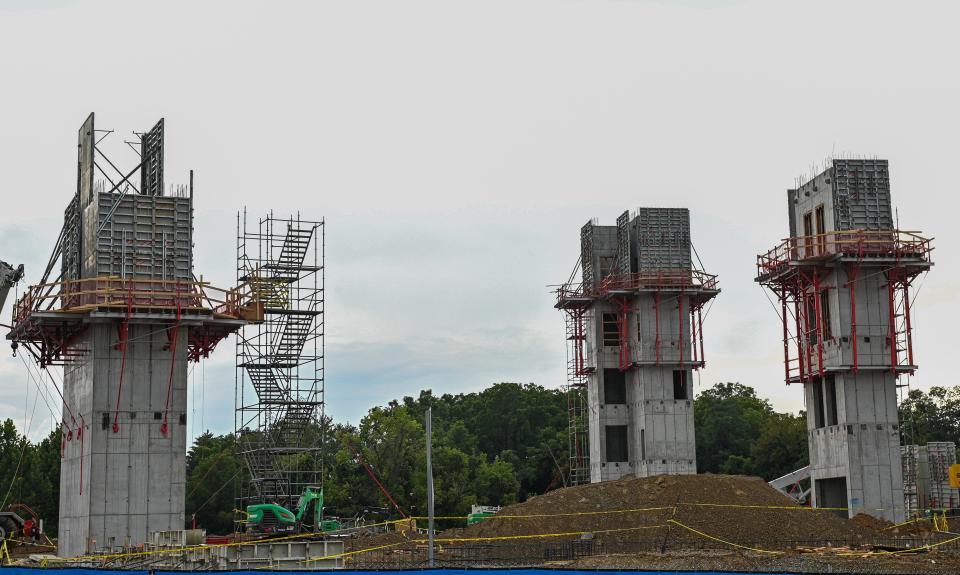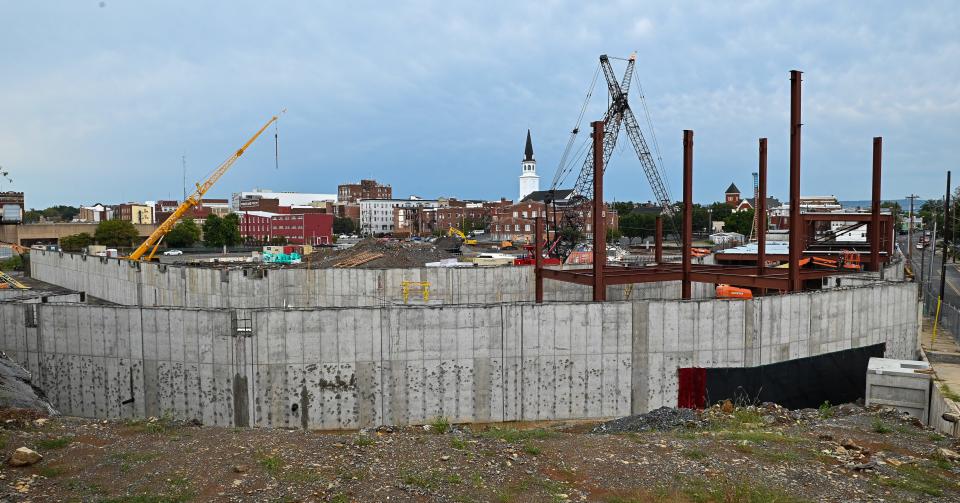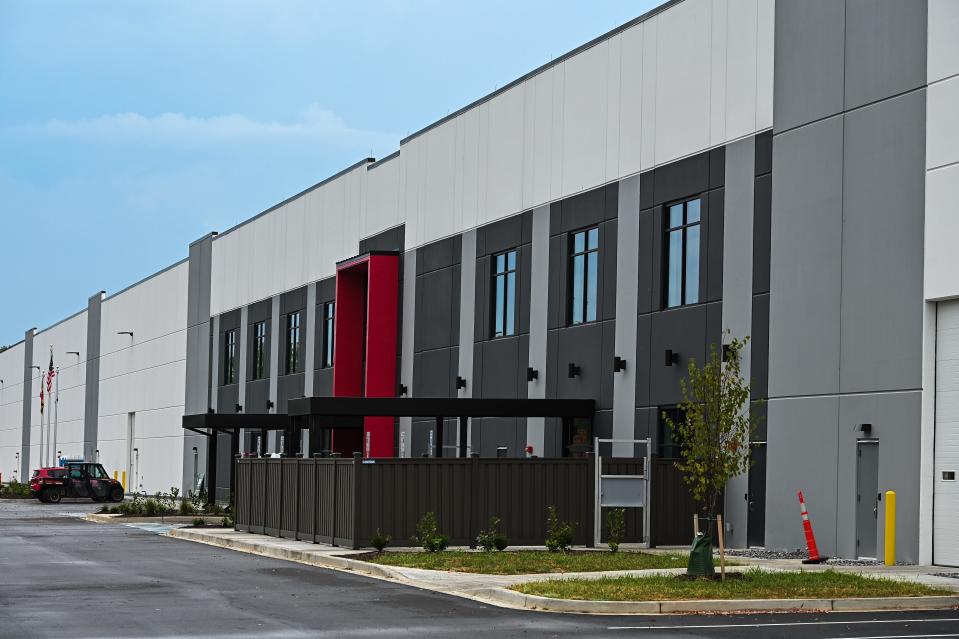Have you noticed all the new development in Washington County? There's a reason for it
Editor's note: This is the first in a series of stories looking at the growth and development in Washington County over the past few years, answering the question "Why now?"
Everywhere you look these days, somebody's building or restoring something.
From major projects (Hitachi Rail, the Meritus medical school, the stadium in downtown Hagerstown) to steady, targeted small business development (Ritchie Revival in Cascade, Port 44 in Williamsport), Washington County's experiencing its greatest growth spurt in decades.
And it's not all warehouses.
After years of sporadic advances, there's a new sense of vision and possibilities, whether it's the expansion of the Washington County Museum of Fine Arts, development of a new park or emerging business ventures.
"I think it has been progressive in terms of levels of investment," said Jill Thompson, director of Community & Economic Development for the city of Hagerstown, where new and recent investments now exceed $600 million — and that doesn't count industrial development within the city, she said.

The new Meritus School of Osteopathic Medicine accounts for $150 million of that figure, Thompson said, even though the school isn't inside the city limits. She believes the school is "going to be a significant economic impact in the region," and will affect "other types of supportive businesses in the health and health sciences field."
"I believe that investment breeds more investment," Thompson said, "so there has been a continuum of momentum that has grown as a result of a number of different factors."

In fact, county officials estimated this summer that planned, under-construction or recently completed investment throughout Washington County stood at nearly $1.3 billion.
That's billion, with a B.
And that doesn't count quite everything.
So given the economic challenges faced here and elsewhere in the last few decades, what caused the stars to align now?
According to the man whose job it is to keep his finger on the county's economic pulse, it's a nearly 40-year overnight success.
Because to find the answer to that question, you have to look back to the era when the preponderance of manufacturing in the county began to wane, says Jonathan Horowitz, director of Washington County's Business and Economic Development Department.
Why Washington County and why now?
"When you say something like the stars align, that's probably the best way to look at it. I think this community has been lining itself up for this type of development, I would say probably since the early '90s, late '80s," Horowitz told Herald-Mail Media.
"My family moved here in the early '80s, late '70s, because of Mack Truck, Fairchild and all the other great manufacturing facilities and jobs that were here … they felt like this was a great place to come raise a family."
But in the mid-1980s, the closure of Fairchild Republic and outsourcing of work from Mack Truck — two of the county's largest employers at the time — fractured the county's reputation as a manufacturing hub. In the ensuing years, more manufacturers would close shop.
"The community took a turn and our manufacturing started falling off. And we started experiencing issues like many communities in the country were," Horowitz said.
At that point, local government officials — supported by the Chamber of Commerce, the Hagerstown-Washington County Industrial Foundation and the formation of the Greater Hagerstown Committee — started taking action to strengthen and diversify the county's economic base.
County officials approached the local legislative delegation for help in creating enterprise zones for business development. New industrial parks were established. Incentives for luring new business to the county were sought.
"(In) this department within county government, there's been efforts to change the direction of that decline," Horowitz said. "The city of Hagerstown has worked very hard through their economic and community development teams as well."

That has included a focus on revitalizing the central downtown business area, where retail business rapidly declined after the opening of Valley Mall in the mid-1970s.
"I think the idea was there — strong downtowns and strong county cores and county seats would make strong counties, and that that's still kind of the philosophy that we're operating from," Horowitz said.
By 2008, those efforts were bearing fruit. Then the real estate bubble burst.
"We were starting to experience some spillover from Montgomery and Frederick counties in terms of residential development," Horowitz said. "We had some strong residential developers coming to town, we had some new elementary schools being built. And unfortunately, with the the collapse of the housing industry and the pop of the bubble there, that taste of success was only a taste of realization.
"And it faded quickly when those developers basically had to sell their projects in response to the collapse of the macro economic conditions in the country."
The silver lining, however, was that this spurt prompted the county to take further actions to prepare for future growth. One of those was the enactment, through enabling legislation from the Maryland General Assembly, of the excise tax.
This tax is paid by developers to help finance schools, parks, roads and other infrastructure needs resulting from growth.
"That was something that was done politically and legally to protect ourselves from the onslaught of development that we saw coming," Horowitz said. "And that was just another thread in the preparation for development.
"If we didn't have the excise tax in place before this last wave of development, we would quite frankly, have given the farm away … we would not have the financial resources to support the infrastructure and the education system that we're responsible for."
The city of Hagerstown embarked on a 10-year strategic plan for redevelopment in the downtown core in 2014, Thompson noted, targeting projects that would spur more of the kind of development that was just getting started before the real estate bubble burst.
Now, she said, "Downtown is is the highest incentivized area in in Washington County, I believe, and the programs offered by our department are the drivers of investment."
But recovery from the real estate bust took several years. And then a few years later came COVID-19.

How COVID put Washington County on the development map
The pandemic brought hardship and more than 600 local deaths, according to the Maryland Department of Health. It also forced "focus onto e-commerce," Horowitz noted. It changed consumer habits throughout the nation.
When e-commerce enterprises looked across the country "for where they needed to be to serve their customers," he said, "Washington County lit up bright red" because of the intersection of Interstates 70 and 81.
Many of them found developing along Interstate 95 was too expensive because most of the property in that north-south corridor was already built out, he said.
And so they started looking at Interstate 81.
I-81 went through communities where the cost of doing business was lower, Horowitz said, and "had greater workforce availability in the industries that were in demand for e-commerce: logistics, trucking, repair, those types of things. So it fit — the stars aligned."
Investors took the risk. Trammell Crow, for example, built a 1.1 million square-foot facility on Crayton Boulevard north of Hagerstown, leased it to Amazon and then sold it for a profit within three years, Horowitz said.
The NorthPoint development on Wesel Boulevard followed, and the returns on those two investments "sent a huge signal out to the development community … and once that happened, the onslaught had begun," Horowitz said.
Industrial property values soared.
"We had roughly $86,000 (per) square acre industrial land in the 2019 timeframe," he said, "and by 2022, we were upwards of $147,000. That's an astonishing increase in property values in a community."
Put another way, that's a nearly 71% increase.
"Certainly the city of Hagerstown has seen development in the warehouse-distribution area as has the county," Thompson said, "so we have a number of projects that the combination of the warehouse distribution and other industrial development is about another $300 million to $400 million."
And now, manufacturing — never completely gone — is returning. An auto parts manufacturer and an HVAC manufacturer recently became part of the Ritchie Revival at the former Army base in Cascade, and Hitachi Rail USA is building a $70 million factory in Halfway.
"We have other very, very strong manufacturing facilities here that are greatly relied on in the national and worldwide supply chain that people just aren't aware of," Horowitz said, some of which are tied to government and military contracts.
And he says even more manufacturing possibilities are on the horizon.
According to his department's estimates, Washington County is on track to gain about 7,000 new jobs in the next few years from all these projects.
'When do we get a Wegmans?'
How do you know when a community has really arrived?
For some, apparently, it's the opening of an upscale grocer.
"My friends, when I took this job, came to me and said 'when are you gonna get me a Wegmans?' … everybody wants a Wegmans. But we're on the path."
Right now the closest store in this East Coast grocery chain is in Frederick, Md. But Horowitz wouldn't be surprised to see the chain venture over South Mountain.
"If people want a Wegmans and they want a — I don't know, like Dave and Busters; I've heard that before — you know, those types of amenities come only because the community has built itself up to that," he said.
"And it starts with the jobs. It starts with these lower-level logistics, entry-level jobs. That's where it all starts. So we're on a great path to revitalize this community back to where everybody wants it to be. But that's a long play, so we're just in the midst of it right now."
Next week: How a unique partnership triggered a rush of investment in the heart of Washington County.
This article originally appeared on The Herald-Mail: Billions in development the fruit of long-term planning, officials say

